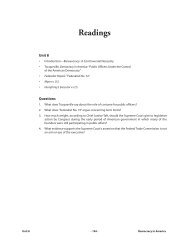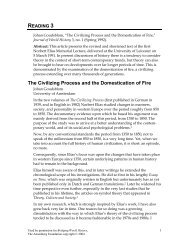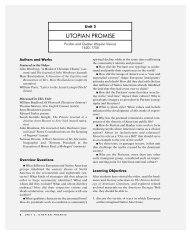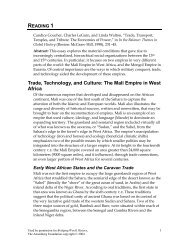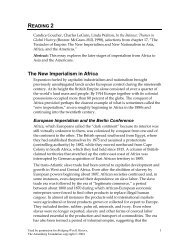Create successful ePaper yourself
Turn your PDF publications into a flip-book with our unique Google optimized e-Paper software.
designs, and “above all… mass production,” including the use of the new<br />
Jacquard loom from France (Reilly, 17, 34, 72–79). 23<br />
American corporations started manufacturing shawls using handlooms in the<br />
Middle Atlantic states in the early nineteenth century, but mechanized<br />
production quickly followed in Lowell and Lawrence, Massachusetts. The<br />
Lawrence “Bay State shawls, composed of a medium-grade American wool<br />
and woven in a simple plaid design, quickly became best sellers.” Shawls<br />
from the Bay State Mills and “cashmeres” produced by the Vasselborough<br />
Manufacturing Company in Maine were sent to the 1851 Great Exhibition in<br />
London, where they were largely ignored, in part due to their inferior quality<br />
and in part because of the accolades heaped on French cashmeres. Latenineteenth-century<br />
U.S. production included woven, printed, and<br />
embroidered shawls, as well as books with knitting instructions for women to<br />
make their own (Leavitt, 55–-58).<br />
French designs and French production came to dominate the shawl trade in<br />
western Europe and the United States before the middle of the [End Page 44]<br />
nineteenth century. A Kashmiri story linked the genealogy of French shawls to<br />
Sayyid Yahya, “a blind [Kashmiri] man,” who visited Egypt in 1796 and<br />
presented the “Khedive of Egypt” with “the” shawl that Napoleon eventually<br />
took back to France (Khandy 1986, 110 note 24). French shawl manufacturers<br />
quickly developed imitations, spurred on when Napoleon’s 1806 continental<br />
system interfered with French purchases of Kashmiri shawls brought to Europe<br />
by British ships (Ames, 136–45). French manufacturers were able to obtain raw<br />
material from Iran, and French shawls woven with pure cashmere warp and<br />
weft, called “French Kashmir shawls,” appeared in 1816. Two years later the<br />
first designs woven on Jacquard looms followed, and, in 1819, a French<br />
manufacturer created the “harlequin shawl,” a distinctly French variation on<br />
Kashmiri design. Popular in the 1820s, this shawl had multi-colored<br />
compartments on each end which contrasted with the enclosed buta design. The<br />
invention of the Jacquard loom in France changed the design possibilities for<br />
European shawl production, and the application of power to Jacquard looms<br />
by the 1870s greatly increased the number of shawls that could be produced<br />
(Ames, 359; Levi-Strauss 1988, 23–28; Schoeser and Rufey, 104).<br />
The European and American popularity of French shawl designs followed<br />
and confirmed France’s established reputation for fashion innovation and<br />
design leadership. French shawl designers were determined to impress their<br />
own taste on European-made shawls from the beginning of the nineteenth<br />
century. Some early French critics characterized the original Kashmiri shawl<br />
ornamentation as “bizarre and muddled” rather than beautiful. French<br />
designers tried “to bring about the demise of the fantastical decorative<br />
schemes of Oriental shawls” for over half a century, but “they failed to<br />
convince women that Europe could outdo the East in artistry” (Levi-Strauss<br />
Used by permission for Bridging World History, 14<br />
The Annenberg Foundation copyright © 2004



